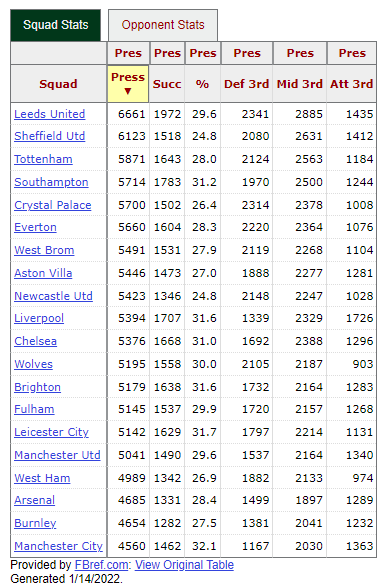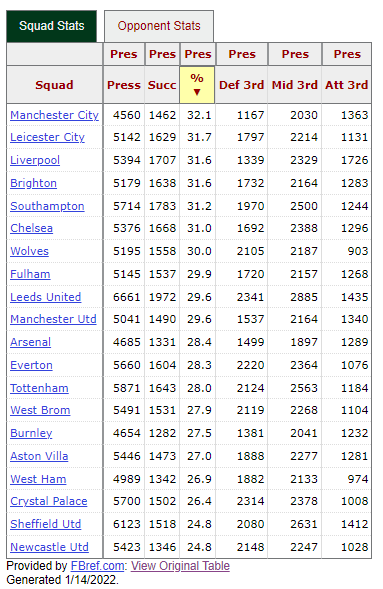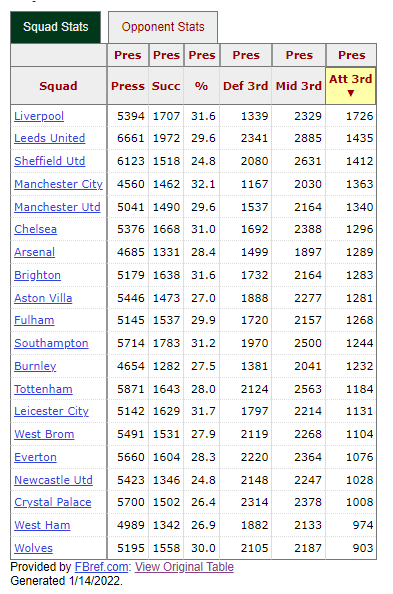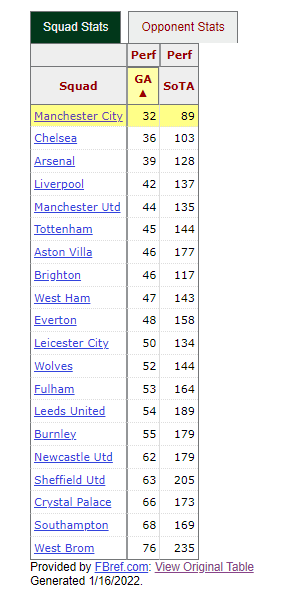Code
import pandas as pd
from google.colab import data_table
import seaborn as sns
sns.set_theme('talk')
import matplotlib.pyplot as pltExploring the relationship between winning record, high-press, and pressure effectiveness.
Luca Cazzanti
January 14, 2022
In this activity I explore the relationship between team performance and team pressure behavior using data from the English Premiere League season 2020-2021. I focus on Manchester City and Sheffield United, respectively the winner and bottom finisher for that season. I describe how points, goals-against (GA) and shots-on-target-against (SoTA) are related to the success rate and the field location of teams’ pressure acvitivies, and how these relationships explai the different final placements achieved by high-perfoming and low-performing teams. The analyzed metrics are related to passes-per-defensive action (PPDA), a summary metric of a team’s efficiency in applying defensive pressure, but in this note I do not look at this metric. Instead I focus on readily available, first-principles metrics that are nonetheless informative with only a minimum of data processing. While my observations are qualitative, they are supported by quantitative and exploratory analyses performed in Python.
While high-press (applying defensive pressure in the opponent’s third of the pitch) is not required for teams to win games, there exist a correlation between winning (points achieved) and using high-press. However, it is not sufficient to simply apply pressure (proximity within 5 meters of an opponent with the ball) in quantity in the attacking third: the quality of the pressure is also important, as measured by the success rate of pressure events (success is winning possession). Furthermore, it is important to also look at the normalized profiles of pressure events across the thirds of the pitch to characterize how a team chooses to distribute its totall pressure effort throughout a match in the three zones: raw counts, even segmented by pitch thirds, are misleading.
For the purposes of analysing a team’s pressure effectiveness, metrics closer to the played game such as GA and SoTA are more relevant than points earned. For these metrics there is a stronger correlation with the success rate of pressure and the proportion of pressure applied in the attacking third.
The statistics of Sheffield United (bottom-finisher) and Manchester City (EPL winner), are surprising at first if we only consider points won. Sheffield produced the highest number of pressures, both in total and in the attacking third, but finished last. Manchester City, conversely, had the fewest number of pressures, yet was the winner. The distinguishing characteristic for Man City is the highest success rate of the pressures and its stronger propensity toward the high-press.
Success in pressure depends on many factors. It is not limited to the individual pressure event that leads to winning possession, but it also depends on the teammates covering the spaces or marking 1:1 correctly, applying their chosen pressure structures correctly, being ready on their jumps-to-pressure, and on any dynamic advantage of the individual players. Manchester City possesses more of these team and individual characteristics than Sheffield United and it is likely better able to choose the moments for applying pressure, increasing the efficiency of pressure activities. This, together with the fact that they practice a higher press, contributes to their low GA and SoTA metrics.
The data was downloaded from FBRef. This exercise is part of the requirements for the course “High-press in Football” from Barca Innovation Hub
# Read the Squads and Players --> defensive actions statistics
data_source = 'https://fbref.com/en/comps/9/10728/defense/2020-2021-Premier-League-Stats#stats_squads_defense_for'
pressure_data = pd.read_html(data_source)[0]
#Keep only what we need
pressure_data = pressure_data[['Unnamed: 0_level_0', 'Pressures']].copy()
pressure_data.columns = pressure_data.columns.droplevel()
# Calculate the percentage of pressure events by third of the field --> will use it later
# Rounding the numbers for readability
pressure_data['Def 3rd %'] = round(pressure_data['Def 3rd']/pressure_data['Press'] * 100,1)
pressure_data['Mid 3rd %'] = round(pressure_data['Mid 3rd']/pressure_data['Press'] * 100, 1)
pressure_data['Att 3rd %'] = round(pressure_data['Att 3rd']/pressure_data['Press'] * 100, 1)
# Read the Squads and Players --> goalkeepeing statistics
goalkeeping_source='https://fbref.com/en/comps/9/10728/keepers/2020-2021-Premier-League-Stats#stats_squads_keeper_for'
goalkeeping_data = pd.read_html(goalkeeping_source)[0]
#Keep only what we need
goalkeeping_data.drop(['Penalty Kicks', 'Playing Time', 'Unnamed: 1_level_0'], axis=1, inplace=True, level=0)
goalkeeping_data.columns = goalkeeping_data.columns.droplevel()
# Calculate the total points for the season for each team --> will use it later
goalkeeping_data['Points'] = 3*goalkeeping_data['W'] + goalkeeping_data['D']
# Keep only what we need
goalkeeping_data.drop(['Saves', 'Save%', 'W', 'D', 'L', 'CS', 'CS%'], axis=1, inplace=True)| Squad | Press | Succ | % | Def 3rd | Mid 3rd | Att 3rd | Def 3rd % | Mid 3rd % | Att 3rd % | GA | GA90 | SoTA | Points | |
|---|---|---|---|---|---|---|---|---|---|---|---|---|---|---|
| 0 | Arsenal | 4685 | 1331 | 28.4 | 1499 | 1897 | 1289 | 32.0 | 40.5 | 27.5 | 39 | 1.03 | 128 | 61 |
| 1 | Aston Villa | 5446 | 1473 | 27.0 | 1888 | 2277 | 1281 | 34.7 | 41.8 | 23.5 | 46 | 1.21 | 177 | 55 |
| 2 | Brighton | 5179 | 1638 | 31.6 | 1732 | 2164 | 1283 | 33.4 | 41.8 | 24.8 | 46 | 1.21 | 117 | 41 |
| 3 | Burnley | 4654 | 1282 | 27.5 | 1381 | 2041 | 1232 | 29.7 | 43.9 | 26.5 | 55 | 1.45 | 179 | 39 |
| 4 | Chelsea | 5376 | 1668 | 31.0 | 1692 | 2388 | 1296 | 31.5 | 44.4 | 24.1 | 36 | 0.95 | 103 | 67 |
| 5 | Crystal Palace | 5700 | 1502 | 26.4 | 2314 | 2378 | 1008 | 40.6 | 41.7 | 17.7 | 66 | 1.74 | 173 | 44 |
| 6 | Everton | 5660 | 1604 | 28.3 | 2220 | 2364 | 1076 | 39.2 | 41.8 | 19.0 | 48 | 1.26 | 158 | 59 |
| 7 | Fulham | 5145 | 1537 | 29.9 | 1720 | 2157 | 1268 | 33.4 | 41.9 | 24.6 | 53 | 1.39 | 164 | 28 |
| 8 | Leeds United | 6661 | 1972 | 29.6 | 2341 | 2885 | 1435 | 35.1 | 43.3 | 21.5 | 54 | 1.42 | 189 | 59 |
| 9 | Leicester City | 5142 | 1629 | 31.7 | 1797 | 2214 | 1131 | 34.9 | 43.1 | 22.0 | 50 | 1.32 | 134 | 66 |
| 10 | Liverpool | 5394 | 1707 | 31.6 | 1339 | 2329 | 1726 | 24.8 | 43.2 | 32.0 | 42 | 1.11 | 137 | 69 |
| 11 | Manchester City | 4560 | 1462 | 32.1 | 1167 | 2030 | 1363 | 25.6 | 44.5 | 29.9 | 32 | 0.84 | 89 | 86 |
| 12 | Manchester Utd | 5041 | 1490 | 29.6 | 1537 | 2164 | 1340 | 30.5 | 42.9 | 26.6 | 44 | 1.16 | 135 | 74 |
| 13 | Newcastle Utd | 5423 | 1346 | 24.8 | 2148 | 2247 | 1028 | 39.6 | 41.4 | 19.0 | 62 | 1.63 | 179 | 45 |
| 14 | Sheffield Utd | 6123 | 1518 | 24.8 | 2080 | 2631 | 1412 | 34.0 | 43.0 | 23.1 | 63 | 1.66 | 205 | 23 |
| 15 | Southampton | 5714 | 1783 | 31.2 | 1970 | 2500 | 1244 | 34.5 | 43.8 | 21.8 | 68 | 1.79 | 169 | 43 |
| 16 | Tottenham | 5871 | 1643 | 28.0 | 2124 | 2563 | 1184 | 36.2 | 43.7 | 20.2 | 45 | 1.18 | 144 | 62 |
| 17 | West Brom | 5491 | 1531 | 27.9 | 2119 | 2268 | 1104 | 38.6 | 41.3 | 20.1 | 76 | 2.00 | 235 | 26 |
| 18 | West Ham | 4989 | 1342 | 26.9 | 1882 | 2133 | 974 | 37.7 | 42.8 | 19.5 | 47 | 1.24 | 143 | 65 |
| 19 | Wolves | 5195 | 1558 | 30.0 | 2105 | 2187 | 903 | 40.5 | 42.1 | 17.4 | 52 | 1.37 | 144 | 45 |
# Define some functions to help the visualizations
def plot_squads(df, x, y, figsize=(10,10), fontdict=dict(size=10),
title='', xlabel='', ylabel='', x_offset=0.1, y_offset=0.1):
plt.figure(figsize=figsize)
sns.scatterplot(data=df, x=x, y=y)
plt.title(title)
plt.ylabel(ylabel)
plt.xlabel(xlabel)
for _, row in df.iterrows():
plt.text(row[x]+x_offset, row[y]+y_offset, row['Squad'], fontdict=fontdict)
def subplot_squads(df, x, y, ax, fontdict=dict(size=10),
xlabel='', ylabel='', x_offset=0.1, y_offset=0.1):
sns.regplot(data=df, x=x, y=y, ax=ax)
ax.set_ylabel(ylabel)
ax.set_xlabel(xlabel)
for _, row in df.iterrows():
ax.text(row[x]+x_offset, row[y]+y_offset, row['Squad'], fontdict=fontdict) The tables below show defensive pressure statistics for teams in the 2020-21 English Premire League, sorted in two different ways: by total number of pressure events and by the team’s success rate of the pressure events.
It is immediately obvious that the total number and the success rate do not follow the same, or even similar, order. In fact, in some cases the order is completely reversed: Manchester City had the lowest number of pressure events, but the highest success rate. Conversely, Sheffield United had the second highest number of pressures, yet the lowest success rate.
| Order by Total Pressure Events | Order by Percent of Successful Pressure Events |
|---|---|
 |
 |
We can gain deeper insight by plotting the data and computing summary statistics, as below. From the scatterplot, we can make the following qualitative statements:

| Press | Succ | % | Def 3rd | Mid 3rd | Att 3rd | Def 3rd % | Mid 3rd % | Att 3rd % | GA | GA90 | SoTA | Points | |
|---|---|---|---|---|---|---|---|---|---|---|---|---|---|
| count | 20.00000 | 20.000000 | 20.000000 | 20.000000 | 20.000000 | 20.000000 | 20.000000 | 20.000000 | 20.000000 | 20.000000 | 20.000000 | 20.000000 | 20.000000 |
| mean | 5372.45000 | 1550.800000 | 28.915000 | 1852.750000 | 2290.850000 | 1228.850000 | 34.325000 | 42.645000 | 23.040000 | 51.200000 | 1.348000 | 155.100000 | 52.850000 |
| std | 506.83969 | 165.806355 | 2.264201 | 339.620357 | 228.299497 | 189.164444 | 4.480704 | 1.113305 | 4.012795 | 11.251199 | 0.296019 | 34.857454 | 16.887476 |
| min | 4560.00000 | 1282.000000 | 24.800000 | 1167.000000 | 1897.000000 | 903.000000 | 24.800000 | 40.500000 | 17.400000 | 32.000000 | 0.840000 | 89.000000 | 23.000000 |
| 25% | 5116.75000 | 1470.250000 | 27.375000 | 1653.250000 | 2162.250000 | 1097.000000 | 31.875000 | 41.800000 | 19.950000 | 44.750000 | 1.175000 | 134.750000 | 42.500000 |
| 50% | 5385.00000 | 1534.000000 | 29.000000 | 1885.000000 | 2257.500000 | 1256.000000 | 34.600000 | 42.850000 | 22.550000 | 49.000000 | 1.290000 | 151.000000 | 57.000000 |
| 75% | 5670.00000 | 1639.250000 | 31.050000 | 2120.250000 | 2380.500000 | 1307.000000 | 37.925000 | 43.400000 | 25.225000 | 56.750000 | 1.495000 | 177.500000 | 65.250000 |
| max | 6661.00000 | 1972.000000 | 32.100000 | 2341.000000 | 2885.000000 | 1726.000000 | 40.600000 | 44.500000 | 32.000000 | 76.000000 | 2.000000 | 235.000000 | 86.000000 |

points_press_corr = all_data['Points'].corr(all_data['Press'])
points_success_corr = all_data['Points'].corr(all_data['%'])
print('Correlation between points and number of pressures: {:f}'.format(points_press_corr))
print('Correlation between points and success rate of pressures: {:f}'.format(points_success_corr))Correlation between points and number of pressures: -0.279062
Correlation between points and success rate of pressures: 0.448378To understand better the pressure characteristics of the teams, we can look at where the teams apply pressure: in their defensive third, middle third, or attacking third (high-press) of the pitch. The table below shows the teams ordered by the number of pressure events in the attacking third. We see that: * Liverpool produce the most pressures in the attacking third, a difference in rank of +9 compared to their total pressure events. * Leeds United and Sheffield United are 2nd and 3rd in most pressures in the attacking third, which is consistent with the fact that these two teams produce the most overall pressure events. * Manchester City are in 4th place, a difference in rank of +16 compared to their total pressure events.

We see that Sheffield and Leeds were among the leaders for pressure events applied in the attacking third, but their final placement in the table is quite different, with Sheffield finishing last, and Leeds in 9th place. Manchester City won the championsip, but had less pressure events overall and in the attacking third than these two teams. The explanation is that we need to look at the distribution of a team’s pressure events in the three parts of the pitch, not just at the raw total counts. This gives us a picture of a team’s preferred zone of pressure application throughout the match. Thus we look at the normalized profile of the pressure events for each team, not just the raw counts. The following figure shows that there is a stonger correlation between points won and the percentage of pressure in attacking third (0.38), compared to considering the just raw numbers (0.23).
Based on these considerations, and the ones from the previous section, we understand that a team’s performance during the season depends on the relative location of their pressure activity and on the quality (success rate) of their efforts.

points_att_pct_corr = all_data['Points'].corr(all_data['Att 3rd %'])
points_att_num_corr = all_data['Points'].corr(all_data['Att 3rd'])
print('Correlation between points and number of pressures in the attacking third: {:f}'.format(points_att_num_corr))
print('Correlation between points and percent of pressure in the attacking third: {:f}'.format(points_att_pct_corr))Correlation between points and number of pressures in the attacking third: 0.231986
Correlation between points and percent of pressure in the attacking third: 0.378874In the previous sections we looked at the relationship between a team’s defensive pressure characteristics, which we narrowed to pressure success rate and proportion of pressure in the attacking third, and the points earned by the team. We now do the same for the GA and SoTA team metrics. To begin with, let’s look at the FBref statistics are in the table below:

Observations:
Relating these statistics with the previous section we, see that the team with be best GA and SoTA preformance (Man City) produced the fewest pressure events, but also had the highest success rate and one of the highest proportions of pressures in the attacking third. Conversely, Sheffield United produced the most pressure events, but with low success and more of the events in its own third. while also having some of the worst GA and SoTA metrics. Therefore, it is not the raw number of pressures that makes a difference, but how the pressure is applied: the success rate and, to a lesser but still significant degree, the location of the pressure.
Indeed the plots below and the corresponding correlation coefficients show a strong negative correlation between GA and SoTA and the success rate and the location of the pressure events:
| Pressure success % | Attcking third pressure % | |
|---|---|---|
| GA | -.56 | -.47 |
| SoTA | -.44 | -.63 |
GA and SoTA are more closely related to the pressure characteristics than points, because they measure quantities more directly dependent on how the team plays: they are closer to the dynamics of the game. The above results also make intuitive sense: the higher the team’s pressure, the less opportunities the opponent will have to take shots on goal, because the opponent is forced to expend effort in their own half and work around the press, away from the team’s goal. On the other hand, while effective at reducing SoTA, a high press may not necessarily result in winning possession, so the success rate becomes more important as it relates to GA.
These results, together witht he comments made in the prevous section, explain the difference in performance between Manchester City and Sheffield United.

ga_att_pct_corr = all_data['GA'].corr(all_data['Att 3rd %'])
ga_suc_pct_corr = all_data['GA'].corr(all_data['%'])
print('Correlation between GA and success rate of pressures: {:f}'.format(ga_att_pct_corr))
print('Correlation between GA and percent of pressure in the attacking third: {:f}'.format(ga_suc_pct_corr))Correlation between GA and success rate of pressures: -0.563937
Correlation between GA and percent of pressure in the attacking third: -0.465390
sota_att_pct_corr = all_data['SoTA'].corr(all_data['Att 3rd %'])
sota_suc_pct_corr = all_data['SoTA'].corr(all_data['%'])
print('Correlation between SoTA and success rate of pressures: {:f}'.format(sota_att_pct_corr))
print('Correlation between SoTA and percent of pressure in the attacking third: {:f}'.format(sota_suc_pct_corr))Correlation between SoTA and success rate of pressures: -0.440233
Correlation between SoTA and percent of pressure in the attacking third: -0.633339I repeat here the summary from the introduction, and conclude with a paragraph on choosing the right metrics.
In this activity I explore the relationship between team performance and team pressure behavior using data from the English Premiere League season 2020-2021. I focus on Manchester City and Sheffield United, respectively the winner and bottom finisher for that season. I describe how points, goals-against (GA) and shots-on-target-against (SoTA) are related to the success rate and the field location of teams’ pressure acvitivies, and how these relationships explai the different final placements achieved by high-perfoming and low-performing teams. The analyzed metrics are related to passes-per-defensive action (PPDA), a summary metric of a team’s efficiency in applying defensive pressure, but in this note I do not look at this metric. Instead I focus on readily available, first-principles metrics that are nonetheless informative with only a minimum of data processing. While my observations are qualitative, they are supported by quantitative and exploratory analyses performed in Python.
While high-press (applying defensive pressure in the opponent’s third of the pitch) is not required for teams to win games, there exist a correlation between winning (points achieved) and using high-press. However, it is not sufficient to simply apply pressure (proximity within 5 meters of an opponent with the ball) in quantity in the attacking third: the quality of the pressure is also important, as measured by the success rate of pressure events (success is winning possession). Furthermore, it is important to also look at the normalized profiles of pressure events across the thirds of the pitch to characterize how a team chooses to distribute its totall pressure effort throughout a match in the three zones: raw counts, even segmented by pitch thirds, are misleading.
For the purposes of analysing a team’s pressure effectiveness, metrics closer to the played game such as GA and SoTA are more relevant than points earned. For these metrics there is a stronger correlation with the success rate of pressure and the proportion of pressure applied in the attacking third.
The statistics of Sheffield United (bottom-finisher) and Manchester City (EPL winner), are surprising at first if we only consider points won. Sheffield produced the highest number of pressures, both in total and in the attacking third, but finished last. Manchester City, conversely, had the fewest number of pressures, yet was the winner. The distinguishing characteristic for Man City is the highest success rate of the pressures and its stronger propensity toward the high-press.
Success in pressure depends on many factors. It is not limited to the individual pressure event that leads to winning possession, but it also depends on the teammates covering the spaces or marking 1:1 correctly, applying their chosen pressure structures correctly, being ready on their jumps-to-pressure, and on any dynamic advantage of the individual players. Manchester City possesses more of these team and individual characteristics than Sheffield United and it is likely better able to choose the moments for applying pressure, increasing the efficiency of pressure activities. This, together with the fact that they practice a higher press, contributes to their low GA and SoTA metrics.
Finally, it is important to distinguish overall win/lose-type of statistics, from more descriptive statistics. While a team’s overall objective is to win, the objective of a tactical/match analyst is to understand their own team and the opponents: simple winning statistics are not as helpful here. Instead, choosing metrics more closely connected to the actions taken on the field, like GA and SoTA in this case, yields deeper undertanding and more fruitful exchange of ideas.
License You may use and modify this Jupyter notebook under the terms of the BSD license.